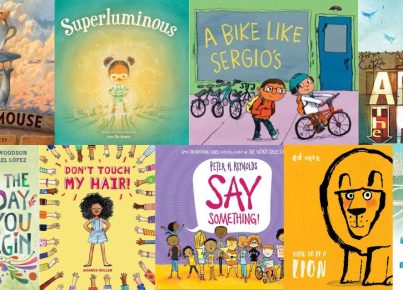Are you looking for high school apps, tools, and resources that you can use with your students? If so, we have you covered. Check out our list below. Let us know if there are any that we missed.
7 Speed Reading– This app can help you become a proficient reader in the English language while eliminating old habits that hold you back. With 7 Speed Reading, students can learn to recognize large clusters of words and read without first vocalizing in their heads.
3D Brain– Apps and AXS Biomedical Animation Studiodeveloped 3D Brain for the Cold Spring Harbor Laboratory DNA Learning Center. The app provides 29 interactive structures and detailed information about the anatomy and physiology of the brain. It also explains how the brain is affected by mental disorders and brain injury; each detailed structure also includes information on functions, case studies, and links to modern research.
The Human Body by Tinybop – The Human Body by Tinybop allows students to explore anatomy and biology through the lens of the human body. With a fully functioning circulatory, respiratory, and digestive system, students can explore the sounds of the heart, the gurgle of the guts, and more. In all, The Human Body by Tinybop covers eight bodily systems: muscular, skeletal, nervous, digestive, circulatory, respiratory, immune, and skin. Students can study interactive organ models, feed the body, watch sound vibrations travel through the ear canal, and learn new vocabulary with in-app text labels. The app also comes with a free handbook for teachers and parents full of discussion questions and additional facts.
A.D.A.M. Interactive Anatomy– An in-depth digital database of anatomical pictures, featuring over 20,000 anatomical images in different planes of view. Structures can be searched in different languages, including English, French, German, Italian, Japanese, Spanish, and many others. Images of different body parts, organs, and systems are available in detailed, colored forms. Images also have relevant and appropriate labeling for easy identification.
Bio Digital Human– Explore the human body in 3-D using the BioDigital Human platform. Choose from thousands of immersive images to build your personal library. Responsive tools, along with detailed medical explanations, provide a fresh visual perspective for understanding the human body. This platform makes the knowledge of anatomy, physiology, pathophysiology, and management of medical conditions accessible and available.
InMind– InMind is a short adventurous app with arcade elements developed for Google Cardboard. This app is great for learning about anatomy as brain tissue and neurons looked so real than you can imagine. It enables players to have a lovely adventure into the human brain to look for the neurons that give rise to mental problems. It is free and can be played with any special viewer.
ZygoteBody – ZygoteBody allows for the in-depth study of anatomy in a completely virtual environment. Students can add notes, dissect parts, pin, sketch, and customize scenes to study any part of the body or bodily system. ZygoteBody has advanced navigation and a 3-D library so students can locate and zoom in on any body part quickly and easily. With a premium account, dissections, notes, and pins can be saved for later reference.
Bone Box – Skull Viewer– This application offers detailed 3-D anatomical models of the human skull using original CT scans. This app is the first in a series and is hosted on the iPad 2 and the new iPad. Designed by anatomists, medical illustrators, animators, and programmers.
Bone Box – Hand Viewer – Features detailed illustrations of the bones of the human hand. Images are not pre-rendered; hence, you can view it from many angles and degrees of zoom for clearer images. Useful for medical and patient education. Images come with default labeled pins, and users can create custom pins.
Algebrator– Algebrator is one of the leading math tutoring apps available. Using Algebrator’s step-by-step explanations of the answers to even the most difficult math problems, students can learn to solve homework problems in a way that is easy to understand. Algebrator can be used by parents, adult learners, and homeschoolers to improving their math skills.
CK-12– Helps students and teachers to improve elementary learning worldwide by making personal education tools available. Learn more than 5,000 math and science topics at a speed that suits you. Math topics include arithmetic, measurement, algebra, geometry, probability, statistics, trigonometry, analysis, and calculus. Science subjects include geography, life science, physical science, biology, chemistry, and physics. Other subjects include SAT exam prep, engineering, technology, astronomy, English, and history.
Elevated Math– This app provides basic lessons on math topics ranging from place value to large number addition and algebra I. It covers about two years of math learning and works on iPads and iPhones. It comes free with two lectures and a video about career choices; additional lessons are available for purchase. This app does not support commercial uses.
GeoGebra– GeoGebra comes with an easy-to-use interface and many features that help you create, modify, and share math simulations and models. It comes with multiple platforms and dynamic math software that brings together tables, graphing, geometry, algebra, calculus, and statistics in a free easy-to-use package. The app also comes with free and open source software; it has received many educational software awards in the US and Europe.
The Human Body by Tinybop – The Human Body by Tinybop allows students to explore anatomy and biology through the lens of the human body. With a fully functioning circulatory, respiratory, and digestive system, students can explore the sounds of the heart, the gurgle of the guts, and more. In all, The Human Body by Tinybop covers eight bodily systems: muscular, skeletal, nervous, digestive, circulatory, respiratory, immune, and skin. Students can study interactive organ models, feed the body, watch sound vibrations travel through the ear canal, and learn new vocabulary with in-app text labels. The app also comes with a free handbook for teachers and parents full of discussion questions and additional facts.
Cell Command– This fun app was designed to teach cell and cell functions to all students, no matter their level of learning difficulty. The game starts with the student controlling a single organelle within a cell, e.g., Ribosome. The students respond to emergencies that involve the organelle they control. Successful interventions are rewarded with cell xp, which they can use to upgrade their “ship,” their skills as a commander, or the skills of their “crew.”
Sonocent – makes it easier to take better notes. With the software, you can capture everything you hear without having to write it down, and you can highlight key points for review with a single click. Plus, you can add your slides, diagrams, and text notes to the same project. The software allows you to record lectures on your laptop or mobile device and to import other media and text notes next to the audio files. The recordings are broken up into smaller chunks of information each time it detects a pause to make the audio easier to organize.
Sutori– Sutori was used for the creation of interactive timelines but is now used to create interactive stories. Teachers can make use of Sutori to create classes and then send codes to students to join. Its features allow teachers and students from around the world to gain access to developer-created stories and projects. These stories and projects are categorized into subjects with several lesson plans.



